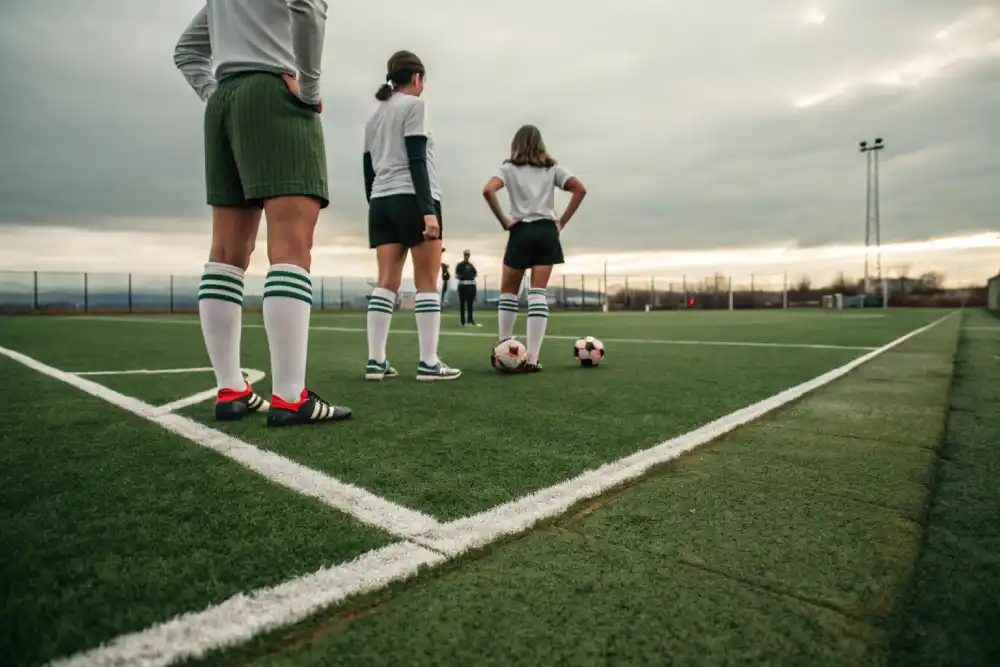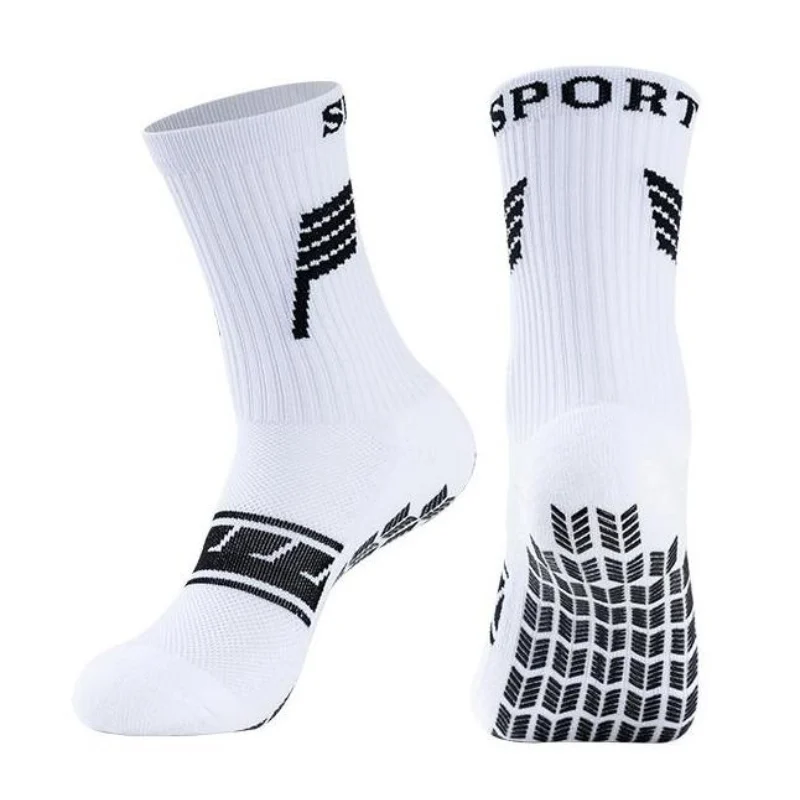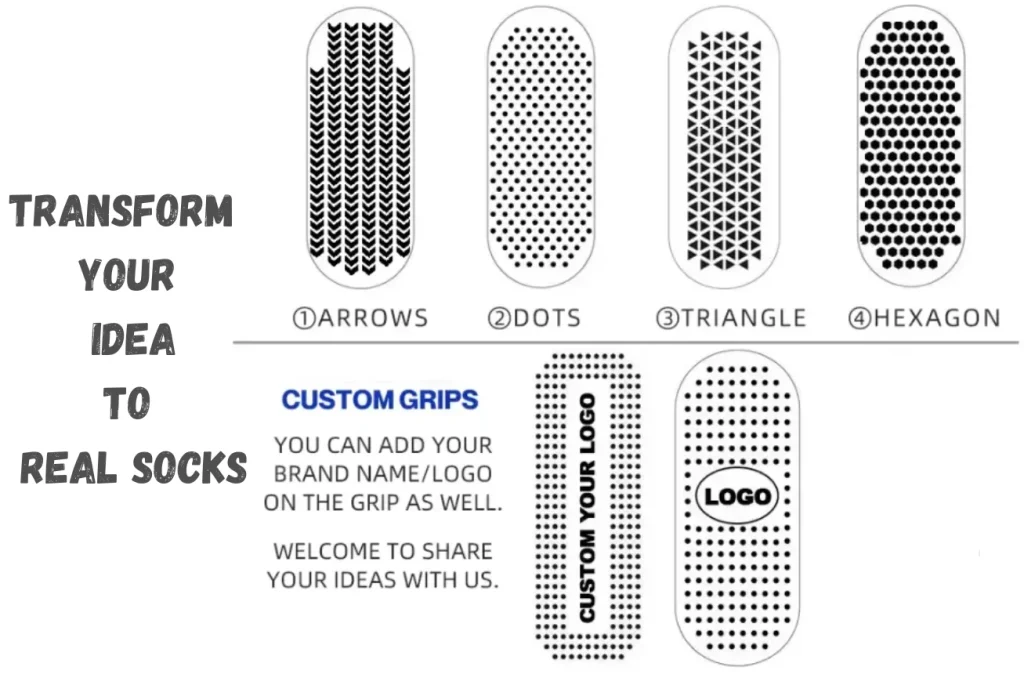Introduction
In the demanding world of soccer, every edge counts. Players constantly seek innovative solutions to enhance their performance and prevent injuries. One such innovation rapidly gaining traction is the grip sock. But what exactly are they, and how do they make a difference on the pitch? For brand owners and retailers looking to fulfill the growing demand for custom socks, understanding the core benefits and applications of grip socks is crucial. These specialized socks are designed to minimize foot slippage within the shoe, offering superior stability and responsiveness, which can be a game-changer for athletes.

What Are Grip Socks and How Do They Work?
Grip socks are not just a fashion statement or casual add-on—they are performance-driven accessories designed to increase foot stability and in-shoe traction. Their core function is simple but powerful: prevent the foot from sliding inside the shoe during movement. This is made possible through strategically placed anti-slip elements—usually rubber or silicone—on the sock’s sole or outer surface.
Think of the textured rubber as a tread pattern, much like those on athletic shoes or tires. These grips generate increased friction against the shoe’s insole or the ground when worn barefoot. By locking the foot more securely into place, grip socks reduce unwanted motion and internal slippage. This stabilization enhances both comfort and control, especially during quick movements.
For athletes—especially in soccer, basketball, or high-intensity training—this added grip makes a significant difference. Without it, a player’s foot may shift slightly with each pivot or sprint, wasting energy and reducing efficiency. Grip socks address this issue by providing a firm interface between the foot and footwear, improving responsiveness and minimizing performance loss.
From a product development or retail strategy perspective, understanding this basic yet crucial functionality is essential. Brands targeting sportswear, team gear, or activewear segments can position grip socks as a technical performance product, not just an accessory. This framing makes the product more compelling to teams, training studios, and performance-focused retailers.
Why Grip Socks Improve Athletic Performance
Grip socks deliver a competitive advantage by reinforcing foot control and power transfer during fast-paced movement. Their non-slip design enhances how the foot interacts with the shoe—offering better grip, fewer internal shifts, and stronger energy return. This is critical in sports where milliseconds and angles determine success.
When athletes sprint, pivot, or jump, any internal foot movement inside the shoe can result in energy loss. Traditional socks lack the friction to prevent this shift. Grip socks reduce in-shoe slippage, meaning more of the leg’s force reaches the ground through the foot, resulting in sharper, more accurate motion.
This increased foot-to-ground efficiency can improve balance and speed across a range of activities. Whether it’s a soccer player making a quick cut, a basketball guard executing a crossover, or a fitness enthusiast holding a plank position—grip socks help maintain footing and control. The outcome is better responsiveness, fewer slips, and greater confidence during each movement.
While grip socks are often associated with soccer, they are equally relevant in other fields: tennis, indoor training, CrossFit, yoga, Pilates, and more. Brands should highlight this versatile use case when marketing to retailers or team apparel buyers. Rather than being seen as a niche product, grip socks can be positioned as an essential performance item across sports and fitness categories.
By reinforcing performance through improved grip and stability, these socks address a critical gap in athletic gear—one that smart brands and retailers can use to differentiate their product offering.
Reducing Injury Risk: How Grip Socks Protect Your Feet
Grip socks offer more than just enhanced performance; they are essential in reducing injury risk by stabilizing the foot within the shoe. When a foot slips during rapid movements, the risk of sprains, twists, and falls increases significantly. By securing the foot firmly, grip socks provide improved ankle support and stability, which helps prevent these common athletic injuries. This support is especially important in sports involving sudden changes of direction and high-intensity actions where the foot and ankle face constant stress.
Minimizing Friction and Blister Formation
Slippage inside the shoe causes excessive friction between the foot and the interior, often leading to painful blisters and skin irritation. Grip socks reduce this friction by keeping the foot firmly in place, significantly decreasing abrasive contact. This not only improves comfort during extended activity but also helps athletes stay focused without distraction caused by discomfort or pain.
The combined benefits of better stability and reduced friction create a safer and more comfortable experience, supporting both injury prevention and sustained athletic performance. For brands, emphasizing these protective qualities in grip socks can position them as essential gear for athletes who prioritize safety alongside performance.
Beyond Grip: The Role of Moisture Management and Psychological Edge
While the primary feature of grip socks is traction, many modern designs integrate advanced moisture-wicking technology to improve overall foot comfort and hygiene. Made from breathable fabrics, grip socks draw sweat away from the skin, keeping feet dry and reducing slippage inside the shoe.

Benefits of Moisture Control
Dry feet are less prone to slipping, which enhances the effectiveness of the grip. Moisture management also limits bacterial and fungal growth, preventing odor and promoting healthier feet. This added comfort allows athletes to maintain focus without distraction from sweaty, uncomfortable feet.
Psychological Confidence Boost
Beyond physical benefits, grip socks provide a psychological edge. Feeling stable and secure reduces anxiety about slipping or injury, allowing athletes to perform with greater confidence and freedom. This mental assurance encourages a more aggressive, focused approach, potentially improving overall performance.
Brands that highlight both moisture management and the mental benefits of grip socks will appeal strongly to athletes seeking reliable, all-around performance gear.
Versatility Across Disciplines: More Than Just for Soccer
Though often referred to as “soccer grip socks,” these products serve a much broader purpose across many sports and everyday settings due to their anti-slip functionality.
Applications in Sports
Grip socks are popular in basketball, volleyball, running, weightlifting, and other activities requiring quick, precise footwork. Their ability to enhance traction and reduce injury risk applies across various disciplines, making them indispensable for athletes in multiple sports.
Use in Healthcare and Daily Life
Beyond athletics, grip socks provide essential safety benefits in medical and elderly care environments. They help reduce falls on slippery indoor surfaces for seniors and rehabilitation patients. Fitness and yoga studios also use them to improve balance on smooth floors.
Additionally, grip socks are becoming common household safety items for children and the elderly, preventing slip-related accidents. This wide applicability presents significant market opportunities for brands, as grip socks meet diverse needs in sports, healthcare, and everyday safety.
Wearing Grip Socks Correctly: Usage and Team Kit Compatibility
Proper use of grip socks is essential to unlock their full benefits, especially in team sports like soccer where uniforms and protective gear are standard. The basic approach is simple: wear the socks so the anti-slip grips make direct contact with the shoe’s insole. However, team settings require a more nuanced technique to maintain uniform appearance without sacrificing grip performance.
Many players use the “cut-off” method—removing the foot section from their regular team socks and wearing this tube over the grip sock. This ensures team colors remain visible while the grip sock delivers traction. When shin guards are mandatory, the order typically follows: shin guards or sleeves first, then grip socks, and finally the cut-off team sock tube layered on top. The key is that the grip sock’s anti-slip dots stay in contact with the shoe interior, preserving effectiveness.
Additionally, the grip sock’s thickness should match regular athletic socks to avoid altering shoe fit or comfort. Before bulk orders, athletes should trial grip socks in training to verify comfort and grip function. Brands can improve customer satisfaction by offering clear usage instructions, ideally with diagrams or videos, helping B2B clients and end users reduce confusion and maximize product value.
Maintaining Grip Socks: Washing and Care Best Practices
To preserve the anti-slip function and durability of grip socks, proper care is vital. Incorrect washing can damage silicone or rubber grips and shorten product lifespan, which impacts customer satisfaction and reorder rates.
Turn grip socks inside out before washing to protect the grips from direct friction. Use gentle wash cycles with cold or lukewarm water and mild detergent, avoiding bleach or harsh chemicals. High heat is harmful—tumble drying or ironing can deform or detach the grip elements. Air drying away from sunlight or heat sources is the safest option.
For bulk buyers and customized orders, providing detailed washing guidelines, expected lifespan, and durability test reports helps build trust and supports client education. Incorporate these care tips into packaging, FAQ pages, or dedicated product care guides to help your B2B clients and their customers extend the functional life of grip socks, reinforcing your brand’s professionalism and commitment to quality.
Customization for Brand Identity: Branding Your Grip Socks
For brand owners and retailers, customization is a powerful tool to build brand identity, enhance market presence, and create unique product offerings. Grip socks present an excellent opportunity for bespoke design, allowing businesses to integrate their distinct branding directly onto a high-demand performance product.

Customization options extend beyond just the sock’s base color. We offer various methods for logo integration, including jacquard weaving, embroidery, or heat transfer printing for sharp, vibrant branding. You can specify custom colorways that align with your team’s colors, brand guidelines, or specific marketing campaigns. Furthermore, custom packaging solutions such as branded boxes, labels, or hang tags elevate the perceived value and provide a premium unboxing experience for the end-user. Beyond aesthetics, customization can also involve tailoring the grip pattern or material density to suit specific sport requirements or target user preferences. Imagine a soccer club with socks featuring their crest and team colors, or a fitness studio offering branded grip socks for their yoga and Pilates classes. This level of personalization not only strengthens brand loyalty but also opens doors for corporate gifting, team uniforms, and unique retail merchandise. Partnering with a manufacturer like Jia Xing Max Hosiery that specializes in flexible and high-quality customization is crucial for bringing your vision to life.
Quality Assurance and Compliance: What B2B Buyers Need to Know
When sourcing grip socks for bulk purchase or private labeling, quality assurance and compliance are non-negotiable. For B2B buyers, understanding a manufacturer’s commitment to these standards provides confidence in product reliability, safety, and customer satisfaction.
A reputable manufacturer like Jia Xing Max Hosiery adheres to stringent quality control protocols at every stage of production, from raw material inspection to final product packaging. This includes testing the durability of the anti-slip grips, ensuring they withstand repeated washing and rigorous use without degradation. We also conduct material safety compliance checks, ensuring that all fabrics and anti-slip elements are free from harmful chemicals and meet international safety standards, especially crucial for products used in direct contact with skin. For specialized applications, such as medical or anti-fall grip socks, specific certifications or testing reports (e.g., slip resistance testing on various surfaces) might be required, and we can provide these as needed. Understanding these quality benchmarks allows you to assure your customers of the product’s reliability and safety. Requesting sample orders and factory audits are excellent ways to verify these claims and build a trusted partnership, ensuring the grip socks you provide are of the highest quality and meet all necessary regulatory requirements.
Targeting the Right Buyers: Market Segmentation for Grip Socks
Understanding the diverse market segments for grip socks enables more effective targeting and product positioning for B2B suppliers. Grip socks serve multiple industries with distinct needs.
Competitive sports teams, such as soccer clubs and goalkeeper academies, prioritize enhanced performance and injury prevention, making them prime customers. The fitness sector—including gyms, yoga studios, and indoor courts—values grip socks for improved stability during training. Medical and elder care institutions seek non-slip socks to reduce fall risks in hospitals, nursing homes, and rehab centers.
Household markets represent additional opportunities, as grip socks promote safety during indoor activities. Furthermore, the customization market adds value by offering branded socks for clubs, businesses, or promotional giveaways. Tailoring marketing messages and showcasing segment-specific success stories will strengthen your positioning, helping clients understand the benefits of grip socks tailored to their unique customer base.
Conclusion
Grip socks play a crucial role in boosting performance, enhancing safety, and providing comfort across sports, fitness, medical, and lifestyle markets. For brands and retailers, offering high-quality grip socks opens doors to diverse business opportunities. Jia Xing Max Hosiery specializes in manufacturing durable, effective grip socks tailored to your needs. Our advanced production and strict quality control ensure consistent excellence and timely delivery. Whether you need bulk orders or custom designs with logos and unique colors, we are ready to support your business growth.
Get in touch today to discuss your project, request samples, and explore how partnering with us can strengthen your product offerings and satisfy your customers.
FAQ
How should grip socks be cleaned to maintain their effectiveness?
Always turn grip socks inside out before washing. Use a gentle cycle with cold water and air dry them naturally. Avoid bleach, tumble drying, and ironing, as high heat can damage the anti-slip grips.
Can grip socks be worn with regular team socks, and how?
Yes, they can. For team sports, players often cut the foot portion off their regular team socks and wear the remaining tube over the grip sock. Ensure the grip sock’s anti-slip elements remain in direct contact with the shoe’s insole.
What sports or scenarios are grip socks suitable for besides soccer?
Grip socks are ideal for any activity requiring enhanced stability and grip. This includes basketball, running, tennis, Pilates, yoga, general fitness, and even medical or home use for fall prevention.
What is the typical lifespan and durability of your grip socks?
The lifespan depends on usage and care. With proper washing and air drying, our grip socks are designed for extended durability. We can provide testing reports for specific models to demonstrate their longevity.
What are your minimum order quantities (MOQ) for custom designs, and what is the customization process?
Our MOQs vary depending on the complexity of the design and materials. Please contact our sales team to discuss your specific customization needs, including logo printing, color matching, and packaging options, and we’ll guide you through the process.
